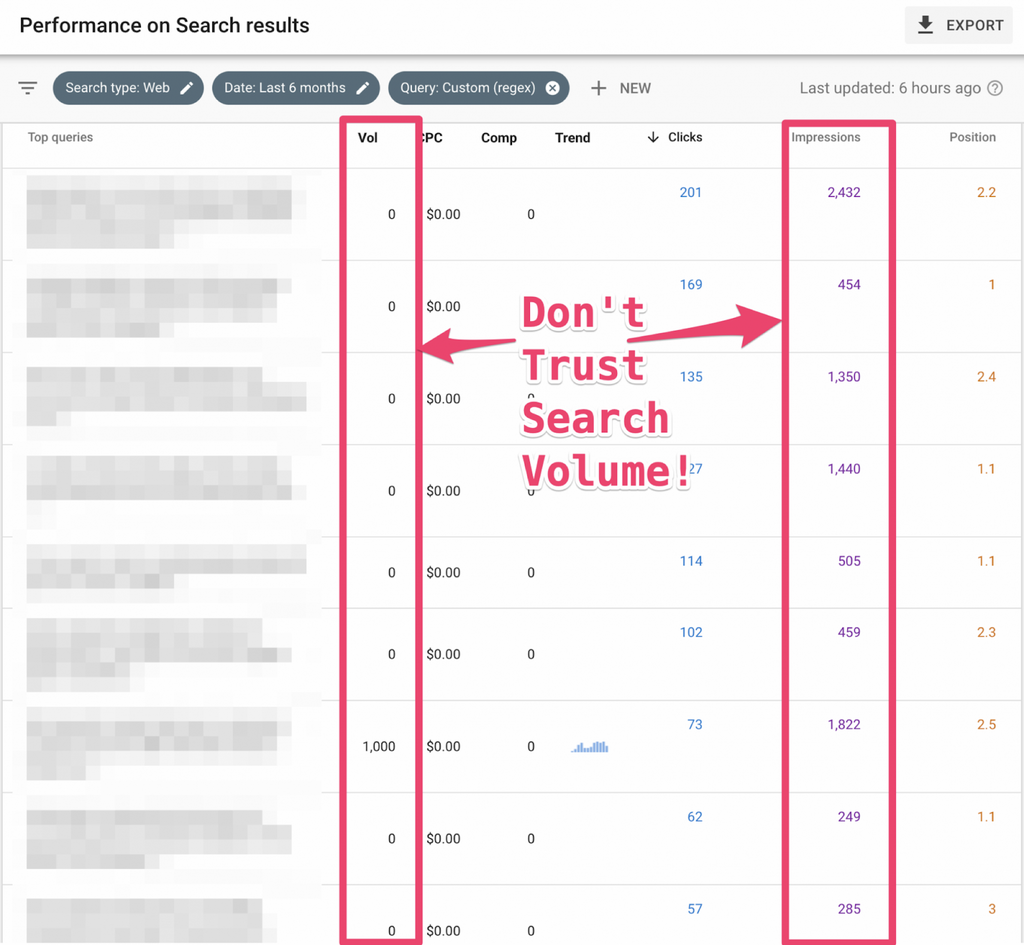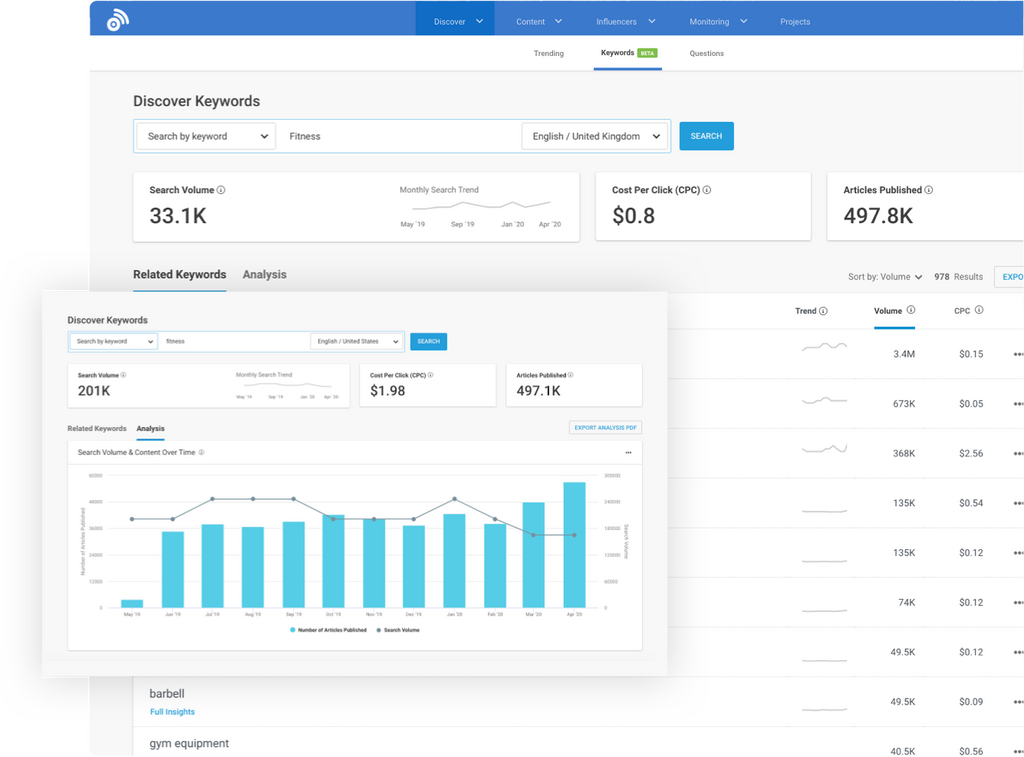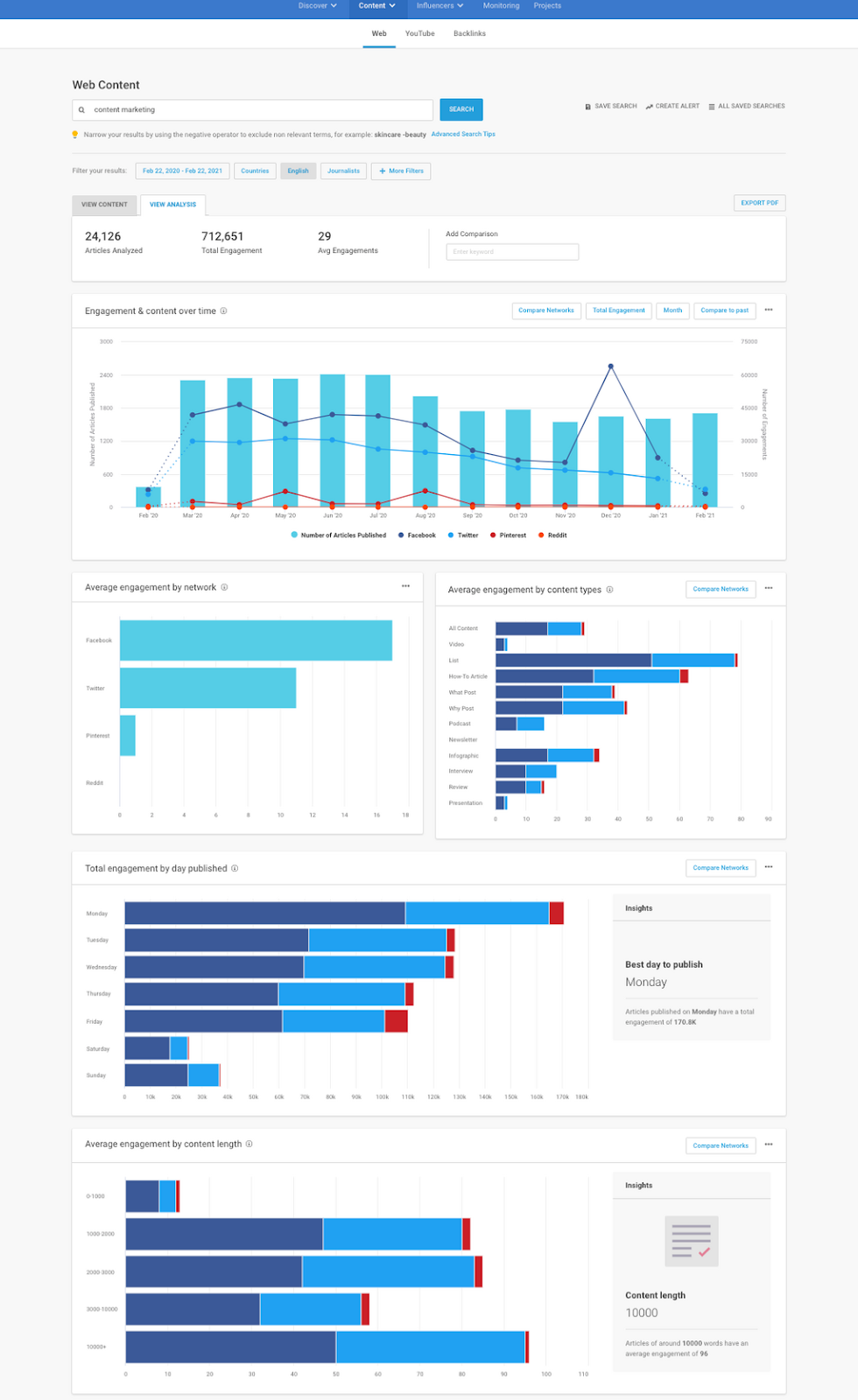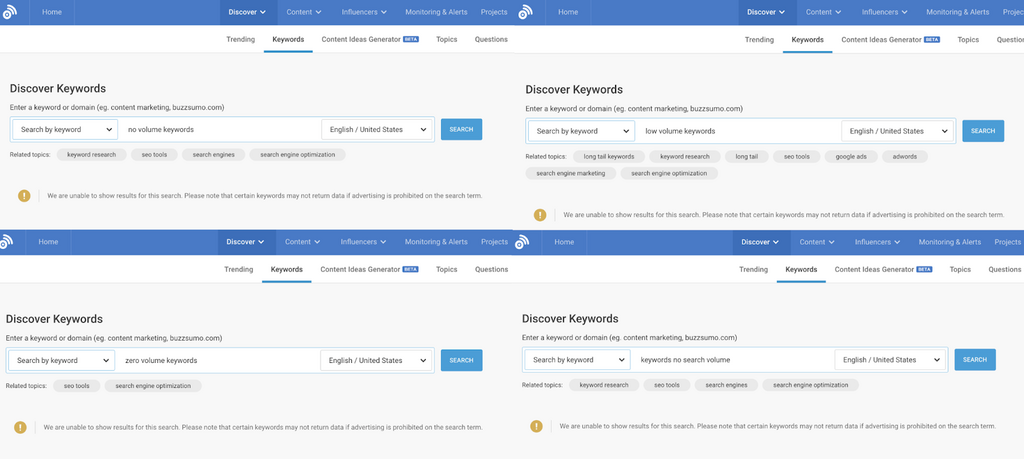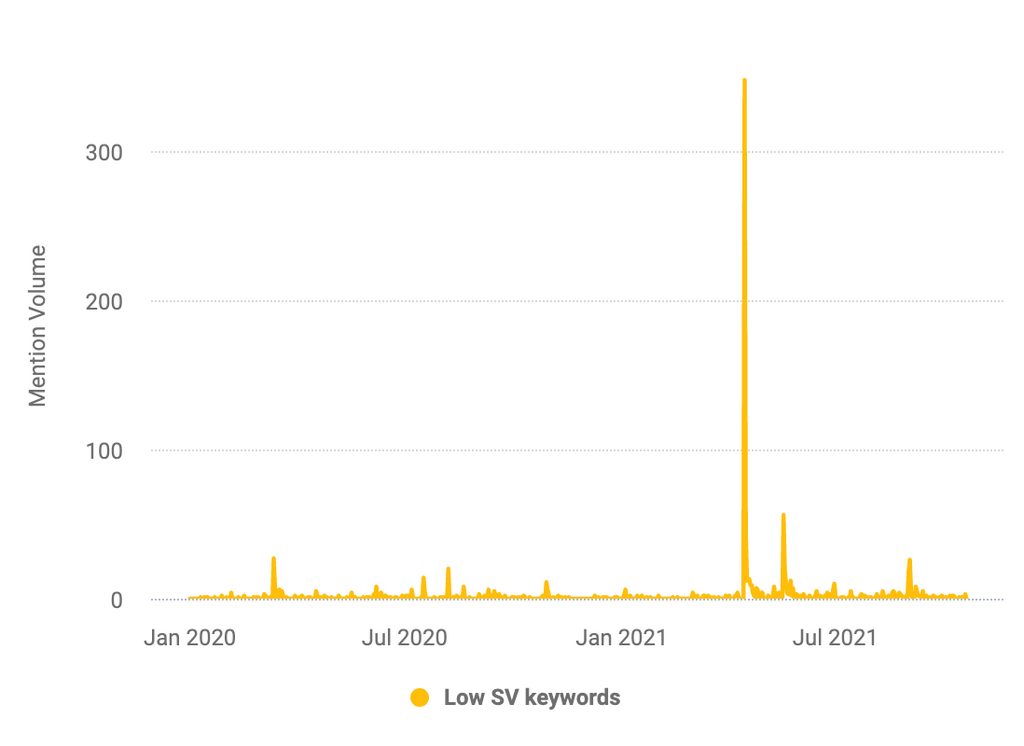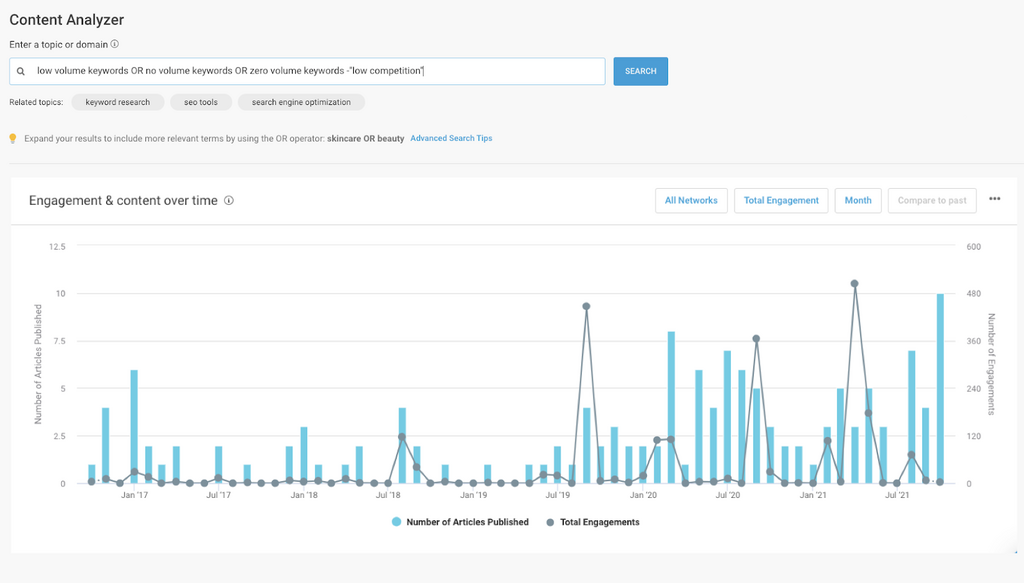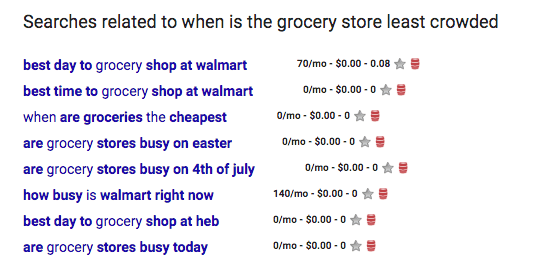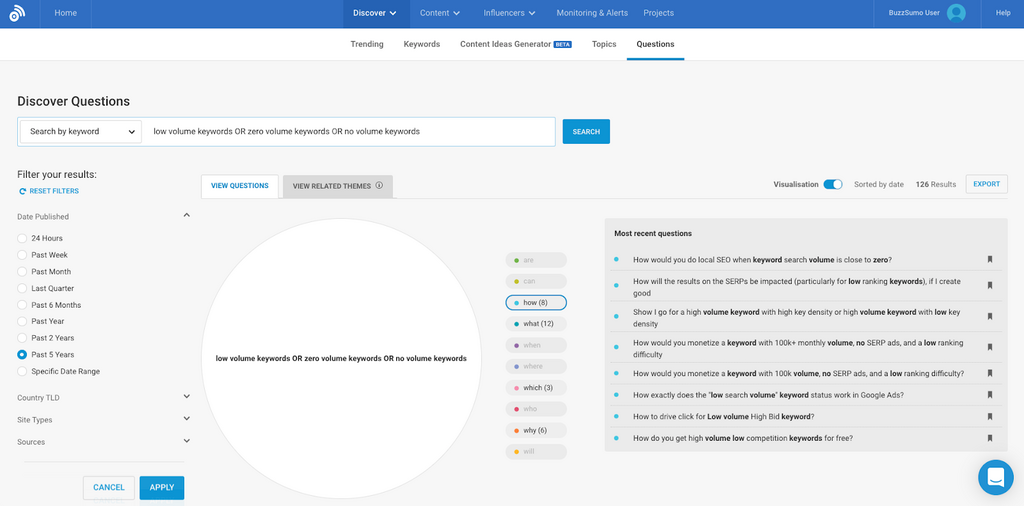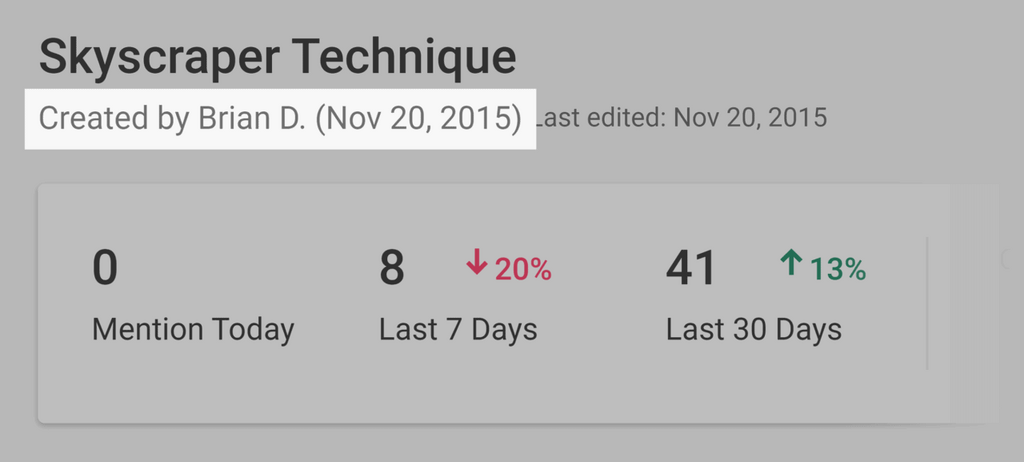Published August 7th 2023
Should you be creating content around low or zero-volume keywords?
One of Steve Toth’s notes on zero-volume searches really got me thinking.
If anything, it got me thinking too much.
The thing about optimizing for zero-volume keywords is that you probably shouldn’t overthink it.
Because if those keywords don't deliver, that's time (and money) wasted.
Well I don’t know about you, but I am an absolute pro at overthinking.
I actually won an award in school: “Most likely to worry about absolutely everything.”
Don’t be jealous 💁♀️
So, naturally, I have given this one a lot of thought.
Hopefully, my overthinking will give you some epiphanies of your own that will translate into some chef's-kiss-content👨🍳😘👌
And since it's more about the doing than the thinking, I'm even putting some of my tips to the test within this very article.
Now that's what I call a META keyword.
I'm here all week. Try the shrimp 😉
Optimize for zero-volume keywords – why would I do that?
I get that optimizing for zero-volume searches seems the antithesis of good SEO and content performance.
It goes against everything that’s been drummed into us content creators since the dawn of SEO.
To tell you the truth, even while writing this blog I am itching to shoe-horn in a stem keyword.
And that’s because keywords are a great safety net.
The safety is in the numbers: search volume, CPC, competition, keyword difficulty.
They reassure you that interest does exist – even if your content doesn’t end up ranking especially well.
But the problem is, relying too heavily on these metrics can sometimes lead to content complacency...
The problem(s) with keyword metrics
Keyword data can be unreliable
Keyword data often comes under scrutiny for being vague and inaccurate.
And I’m not just referring to that time Google replaced exact search volumes for volume banding in the keyword planner.
You don’t have to look far to know that keyword data should be taken with a pinch of salt.
Even while writing this article, I stumbled over a bunch of forum questions surrounding the volume discrepancies across keyword tools.
Steve Toth kicked-off this scrutinous chatter again lately with his ZSV note.
Sharing a screenshot of his clients’ Google Search Console, Toth compared the thousands of impressions they’d landed for long-tail (16+ words), low-volume phrases against a sorry-looking search volume column full of zeros.
His point: keyword data can’t always be trusted.
So, how can you really know whether a low-volume keyword is in fact low in volume if keyword data itself isn’t wholly reliable?
Well, don’t get me wrong. I’m not advising you to stop using keyword tools.
I mean, I’d be pretty bad at my job if I was, since BuzzSumo has its own Keyword Tool…
Keyword data is still a solid way to assess whether there’s an appetite for your content.
And it’s a well-known fact that keyword optimization can and does work.
But Steve’s example is a nice little reminder that keyword metrics aren’t the be all and end all.
And they shouldn’t stop you exploring the new content opportunities that low- or no-volume keywords may just bring about.
“When you successfully target a low-volume keyword, you can usually expect to get anywhere from 3 to 30 times the traffic you’d expect based on the volume — or even more, in my experience.”
Evan Porter
Owner, Words by Evan Porter
Contributor to Niche Side Project
It’s tricky to get green-field ideas from high-volume keywords
Another thing keyword data is not built for is unearthing trending topics and ideas.
Back in 2017, Google stated that 15% of searches had never been searched before.
But keyword tools won’t necessarily show you these new search opportunities.
Why? Because they are snapshots into the past.
Keyword tools average search volumes out over the month.
This means data collection is delayed, demand peaks and troughs are normalized, and new or trending keywords often go undiscovered until months later.
And boy do I know this!
I used to work for an SEO platform, and I can’t tell you just how frustrating it was to have to wait for a full month to collect keyword trend data to fuel our blogs and industry reports.
It meant we couldn’t chime in on reactive or unfolding topics using our own data, because we were always at least a month behind the news cycle.
“Other SEOs and content writers are probably disregarding [these kinds of keywords] due to low search volume: advantage you.”
Steve Toth,
Founder, SEO Notebook
If you’re not hung up on validating your content with keyword volume data, you’re free to write about new topics that are gaining momentum right now.
And that doesn’t mean covering news stories that get forgotten about after a week.
It means trailblazing the next big evergreen topic, and introducing your industry to an entirely new set of keywords.
Search volumes can lead to generic, homogenous content
If you live by search volume data, you stand the chance of missing out on creating hugely valuable content, out of fear that it will never rank or be seen.
Think about it.
If we’re all obsessed with the same keyword metrics, and using the same tools as our competitors, we’re probably also going to be creating the same content.
Keywords shouldn’t be the content idea – but we’re all guilty of building our content around keywords.
And there isn’t a formula for creating the perfect piece of content – but we often apply a check-box approach to content creation.
Creating content is an art, not a science
What we should be doing instead is thinking like journalists, and finding the story.
Forgetting about search volumes every now and then can be liberating.
It means you prioritize instinct and your audience’s intent.
You look for ideas in novel places.
You get more creative.
And, in doing so, you can create some super valuable, unique, and tailored content.
High-volume keywords aren’t future-proofed
High-volume searches are usually short – one, two, maybe three words long – if that.
They’re general topics rather than detailed queries.
We usually optimize around a high-volume keyword and maybe a handful of secondary ones.
Optimizing this way has worked well in the past, since search engines haven’t had the power to understand more specific questions and intent.
But we all know that’s changing, with advancements in AI, ChatGPT, Google EAT, NLP, BERT, MUM and all these other self-learning, acronymous algorithms.
Understanding intent and providing a better UX is the ultimate goal of search engines today.
And low-volume keywords put intent front and center.
Why? These keywords are usually long, detailed, and specific queries that users have asked a search engine.
By answering these queries, we can create more tailored content, better satisfy user intent, and ultimately land higher rankings in a less competitive space.
What’s more, many low-volume queries are essentially the same question asked in different ways.
If they don’t already, it’s pretty likely that search engines will begin to understand the synonymous relationship between these queries.
And when they do, they’ll have the ability to serve up your content for potentially hundreds of low-volume keywords in the SERPs.
On the flip side, generic (read: short-tail, high-volume-keyword-optimized) content will likely be deprioritized over time if it doesn’t correctly address intent, and solve specific pain points.
So, by that measure, optimizing for low-volume keywords is a way of future-proofing your content.
How do you rank with low-volume keywords?
Create link-worthy content
I probably don’t need to tell you the power of links when it comes to ranking.
Original research, theories, data, opinion pieces, interactive campaigns – these are all examples of link-worthy content where keywords are secondary.
Digital PR is built on this method and, in fact, BuzzSumo’s success is too.
Since 2014, we have used our own data to study and test all elements of marketing.
For example, we regularly analyze the 8bn+ pieces of content in our Content Analyzer database to create primary research.
Tons of our blogs and reports have been published for low-volume keywords or are technically “un-optimized”, and yet we get hundreds of thousands of organic visits every year through this research.
Create content people want to share
Shares don’t directly correlate with rankings, but awareness can definitely lead to traffic.
The types of content above that are ripe for landing links will naturally get shared too.
But creating shareable content is also about tapping into social conversations and trends.
If you know a topic is gaining momentum on social, do you really need to check its search volume to validate your idea?
If I just paid attention to keyword volumes, I wouldn’t be writing this blog 🤷
But, as you can see below, social engagement around “low-volume keywords” tells a different story.
There’s a healthy amount of shares and conversation around content of this ilk.
Tap into your community
Involving your community means you have a ready-made audience for your content once you publish it.
This “awareness-you-prepared-earlier” can trickle-down into rankings.
Turn to Slack, LinkedIn, Facebook groups, forums, your email contacts, industry influencers – any group that might have an interest in what you’re creating, and rally the troops for:
- Expert opinions
- Quotes
- Examples
- Interviews
- Day-in-the life blogs / vlogs
- Case studies
- UGC
- Polls
- Surveys
- Webinars
- Podcasts
Don’t focus on “keyword numbers”, focus on the “number of keywords”
According to Evan Porter from Niche Site Project, you should be optimizing a single page for multiple low-volume keywords if you want to see a boost in traffic and rank in the SERPs.
He coined the term “cluster keywords” to describe an approach which involves optimizing your content around numerous ZSV keywords with shared intent.
“Cast a wide net over a dozen or more 0 or low volume keywords that are all basically the same thing. Maybe each one only brings a few people per day or month, but in aggregate, they amount to some serious traffic. Intent is a consideration here too. These cluster keywords have to share the same intent (ie. know, do, go etc.)”
Evan Porter
Owner, Words by Evan Porter
Contributor to Niche Side Project
Where can you find and validate low-volume keywords?
Look for repeat questions, topics, or discussions across:
1. Slack communities
2. Facebook groups
3. Forums
4. The subheadings of high ranking content
5. Google’s page one SERP features, including...
- Answer box
- Text ads
- Related searches
- People also ask
- People also search for
- Google image suggestions
- YouTube video carousel chapters
6. Social media trend tools
7. Social listening tools (ie. Twitter advanced search or Brandwatch Consumer Research)
8. Website search bar
9. Customer and sales teams
10. Customer messaging bots (ie. intercom)
11. Twitter polls and hashtag chats
12. Audience surveys
How do you monitor the performance of zero-volume keywords?
Ad impressions
As you’ve seen, low-volume searches can potentially drive big impressions.
And you can turn ad impressions into search volume estimations really easily.
Just take your ad impression data for the week and multiply it by four to get the equivalent of a month’s worth of search volume data.
Then benchmark your content performance against your traditional high-volume keywords.
This will help you work out whether the time you invested into your low-volume keywords was efficient and worth scaling.
GSC impressions, clicks, and traffic
As with all content, paying close attention to your Google Search Console and Google Analytics data will help you measure content performance.
Keep an eye on whether your zero-volume keywords lead to clicks or conversions.
This can help you build a business case for your zero-volume keyword strategy.
“As your company grows, observe Search Console’s live data closely and rely less on SEO tools, which can take a while to dig up new keyword data.”
Evan Porter
Owner, Words by Evan Porter
Contributor to Niche Side Project
BUT, bear in mind that Google has confirmed that its GSC performance reports are affected by bot traffic, so be wary if you see any unusually high traffic for an unassuming, low-volume keyword.
Tim Soulo, CMO of Ahrefs, has seen unreliable data in GSC. His theory? Rank tracking bots.
SEO Quiz:
— Tim Soulo 🇺🇦 (@timsoulo) September 21, 2021
Google Keyword Planner shows 480 searches for the keyword "SEO report" in July.
But Google Search Console shows 2,327 Impressions for the same month.
Can you guess why? 🙃 pic.twitter.com/32QBf6oOwR
Mentions
If you’ve coined your own low-volume keyword, and want to analyze its uptake, set up a keyword alert to monitor mentions across the web.
Brian Dean did just this with BuzzSumo’s own monitoring tool, when he invented the now firmly-embedded marketing theory “Skyscraper technique”, which averages 150 searches a month.
What content marketers have to say on no-volume keywords...
No-search content takes time to research
“I usually prioritise intent over volume, even if that hurts traffic.
That being said, if there is literally no volume, or almost none, then you have to crunch the numbers.
And a no-search piece of content doesn't take any less time to write than a high-volume piece of content.
So it's a pretty tricky calculus 🥴
All that being said, we cranked out a bunch of super specific low volume pages last summer, and we do still get leads from those pages, with literally no promotion at all.
You can't even navigate to them from the homepage!
[In an ideal world] I'd have a writer in the background just cranking out 1000 articles of every conceivable low volume high intent term we can think of.”
Tom Bangay,
Director of Content, Juro
As Tom rightfully points out in the quote above, creating content around zero-volume search terms isn’t just a case of writing whatever pops into your head.
You still need to do a certain level of research to determine whether there's audience interest in your topic.
There is a risk you might take more time on zero-volume keyword research, since you have less concrete evidence (ie. keyword data) to prove interest in the topic.
This is why it’s crucial to limit your research time, and make sure to create Minimum Viable Content (MVC) to make sure you don’t spend too much time on what is essentially a riskier strategy.
Work with CS, sales, and clients to find LV keyword opportunities
If your industry is pretty obscure or niche, low-volume keywords mined from conversations with CS, sales, or your clients may be just the ticket, according to Tory Gray, Founder and Principal SEO Consultant at The Gray Dot Company
“We don't allocate a specific % [of our content strategy to zero-volume keywords]; we are simply willing & able to pursue a topic as suggested by a knowledgeable client (or, say, their sales or CS team who talks to customers, so they really know what people are asking about or confused about.)
Some clients have inherently more "niche" subject matter, and we end up doing low- to no-KV subject content up to 75% of the time.
Others in less niche subjects have a much smaller ratio, largely driven by those client insights.
B2B also tends towards more low to no SV more often given that they aren't selling to the general public.
We can find more ideas in Answer the Public or PAA or Quora/StackExchange, but we more often prefer talking to the people who talk to the customers - who therefore "see" those repeating patterns.
So yes - we very much buy into allegedly "zero-volume keywords". Just because a tool can't find it, doesn't mean it's not a valuable part of the user conversion journey!”
Discover high-volume keywords from no-volume keywords
Even if you have no intention of ranking, content tends to pick up at least one keyword in the SERPs.
Tory Gray makes another great point about how zero-volume content can be a great “test-and-see” tactic for spotting new keyword opportunities.
"I also find that it's worth trying if the client just has a hunch.
Why not... experiment? Check back in 6 months and see how it's doing.
It's not like you can't retire a post later if it doesn't go anywhere... plus that 6-12 months later you may rank for keyword variations you didn't expect, and you can improve targeting for those because you now have real data on it”
Tory Gray
Founder, Principal SEO Consultant,
Give no-volume keyword content a dual purpose
Love what Tory said. Quick thing to add re: [low-volume keywords as a] safety net:
Sometimes it's easier if the article in question has a dual purpose.
For example, if it helps communicate something your sales team is often trying to explain, or if it's a good resource for current customers/clients.
Amanda Milligan
Head of Marketing,
Make sure you have an alternative promotion plan
“I don’t research keywords 100% of the time. Not every article that I publish is something that people search for.
I’ll give you some examples. I once wrote a post that was about productivity tips for marketers. It’s not really a topic that I could find a good key phrase for.
Another one I wrote was “Pictures of 27 Marketers Desks”. It was actually one of the most successful pieces I’ve run in the last year or so. It was like a mini viral event.
Influencers and top YouTubers shared pictures and lists of their gear. But that’s not something people search for.
So, every piece of content should be created with a promotion plan.
That one was built to be shared, because there were lots of contributors, it was super visual, and it was kind of unexpected.
So with every piece of content, you need to have some concept of how it’s going to get traction.
If it’s not search, it should be something else. Not every topic is being searched for. But with whatever you’re making, don’t wait until it’s live before you start thinking about how to promote it.
That’s too late.”
Andy Crestodina
Founder
Quote taken from the Stunning Digital Marketing podcast
So, should you invest in zero-volume keywords?
High-volume and no-volume keywords both have their place in your content strategy.
While the former is great for helping you justify your content decisions, the latter can help you shake up a stagnating strategy, and re-prioritize intent.
Don’t be afraid to dedicate a % of your strategy to low-volume keywords, if you have a good reason for doing so.
Whether that’s to answer pain points that regularly crop up in sales conversations, prioritize creative ideas, or test out new promotion strategies.
You never know – it could be the best thing you ever do!
Categories
SEOCategories
SEOThe Monthly Buzz⚡
Subscribe to BuzzSumo's monthly newsletter to:
Stay up-to-date with the best of the best in content marketing 📝
Get data-informed content, tips and tidbits insights first 👩🏻💻
Read top shared content by top marketing geeks 🤓
Try
Enter any topic, term or url to search to see BuzzSumo in action. It’s free!
100% free. No credit card required.

